Contemporary Pagans: Indigenous or Not?
This year's parliament in Melbourne listed "Reconciling with the Indigenous Peoples" as one of its key topics.
Some contemporary Pagans have been playing the "indigenous card" since the 1970s, when Oberon Zell and other Green Egg writers argued that Wicca was a form of "indigenous European shamanism."
The same claim has been made by some British Pagans in controversies over the management of megalithic sites in the UK and the treatment of prehistoric remains.
So are today's revived and re-created Pagan traditions "indigenous." I think not—not because they lack ancient roots, but because they are not generally connected to land claims and other current political issues.
In academia, in the world of [Fill in the Blank] Studies, "indigenous" has a more limited—and more political—meaning. Hang around the people teaching, for example, Native American religion, and you may be told that the descriptor "indigenous" can only be applied to people who are or have been oppressed or colonized.
This claim might seem illogical. After all, were the ancient British not oppressed, and thus not "indigenous," until the Romans came and created the province of Britannia—at which point they were colonized. And then when the Roman legions left, they were not "oppressed" anymore, so not "indigenous."
Forget it. This is all about political issues now.
If you cut through the rhetoric, what is really at stake in discussions of who is "indigenous" is land—and sometimes related issues of political power, reparations, and trying to avoid sharing the guilt for how screwed-up the modern world is.
Most Anglosphere contemporary Pagans do not directly connect following an "earth-based religion" with political control of acreage itself, but in other places that connection is the underlying concern.
Particularly in eastern Europe, today's revived Pagans have made "blood and soil" arguments, saying that their approach is truer to the land than is Orthodox Christianity.
Anglosphere Pagans may invoke a sort of metaphorical or historical "indigeneity," talking about people who followed polytheistic religions a millennium or two in the past. In the West, our connections with our Pagan ancestors are intellectual (based on books) and theological.
We can talk about prejudice and Christian hegemony—but being blocked from giving a prayer at the county commissioners' meeting is not "oppression" in the sense that the Australian Aboriginals suffered, for example.
Islam, too, has its "death to the polytheists!" passages in the Qu'ran. Indeed, I think anyone who opened a Pagan bookstore, etc., in Cairo or Islamabad would be oppressed in a hurry. Is anyone brave enough to revive the worship of Ishtar in Iraq?
In our religious views and practices, we have much in common with the tribal religions of the world. In the academic study of religion, common ground is being found between "indigenous" and "Pagan."
In that limited sense, it is useful to show contemporary Paganisms' (that is a plural possessive) roots in pre-modern, polytheistic, or "indigenous" cultures.
But before playing that card, we have to understand that it is usually connected to issues of land rights, grievances over such issues as removal of children into government boarding schools, and other current political struggles.
In those instances, the typical Wiccan, Heathen, etc., is probably going to be on the sidelines.
Labels: nature religion, Paganism
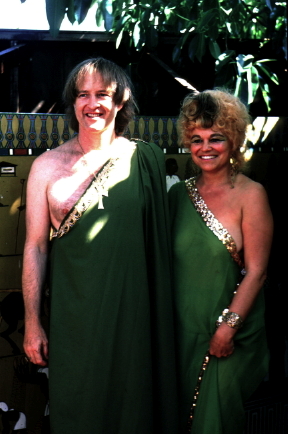 I learned today of the passing on August 9 of Frederick McLaren Adams, co-founder of the Southern California Pagan group
I learned today of the passing on August 9 of Frederick McLaren Adams, co-founder of the Southern California Pagan group 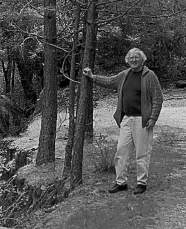 I have a framed front page of the Autumn 1968 issue of the Feraferia journal hanging over my computer desk. Its subtitle reads "The Charisma of Wilderness, Seasonal Celebration, Visionary Ecology." Forty years ago -- before most Pagans were even using the term "nature religion."
I have a framed front page of the Autumn 1968 issue of the Feraferia journal hanging over my computer desk. Its subtitle reads "The Charisma of Wilderness, Seasonal Celebration, Visionary Ecology." Forty years ago -- before most Pagans were even using the term "nature religion." ) appear on the BBC Radio 4 to discuss
) appear on the BBC Radio 4 to discuss 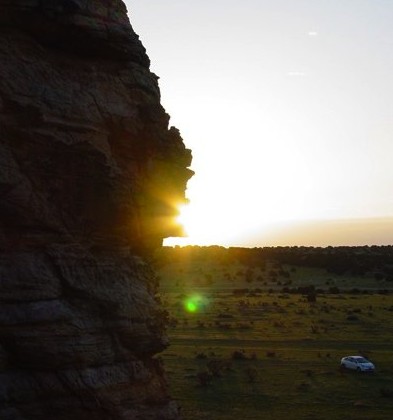 In the photo, the Beltane Sun (astronomical Beltane--May 5) has recently risen. When it appeared on the horizon, it fit right into the little notch in the rock just below its current position--an alignment that happens only on Beltane and Lammas.
In the photo, the Beltane Sun (astronomical Beltane--May 5) has recently risen. When it appeared on the horizon, it fit right into the little notch in the rock just below its current position--an alignment that happens only on Beltane and Lammas.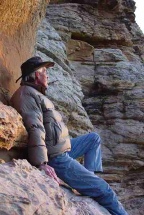 Left: Martin Brennan viewing the sunrise.
Left: Martin Brennan viewing the sunrise. 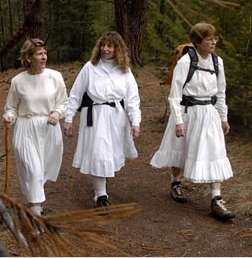 Ladies in White, three women in Missoula, Montana,
Ladies in White, three women in Missoula, Montana, 


